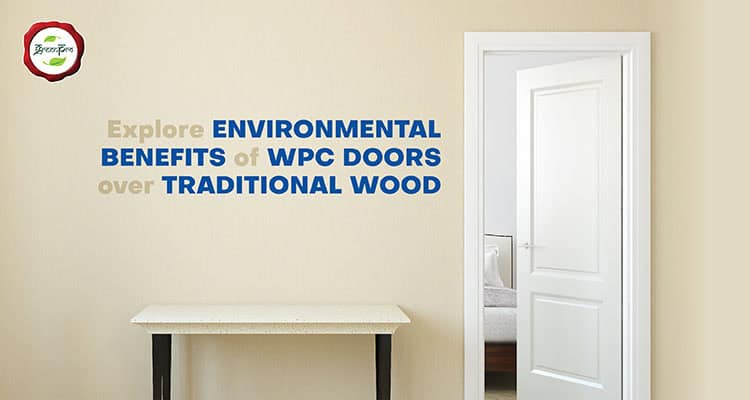The perils of environmental damage have become more palpable than ever. As a consequence of this crisis, there has been a paradigm shift in the way consumers are making purchasing decisions. According to estimates, more than 60% of millennials and over 75% of GenZs are willing to buy at a relatively higher price if the product is eco-friendly.
Therefore, the concept of sustainable and environmentally conscious production is trickling down into every vertical — including the housing and real estate sector. Expectantly, a very crucial pivot can also be seen in the choice of doors. While wooden doors have been a staple of the Indian household for the past several decades, new-age customers are now opting for WPC doors.
Why? Because WPC doors are a conscious innovation to protect and conserve the environment while serving the needs of customers better.
What are WPC doors?
Wood Plastic Composite (or WPC) doors are elegant and eco-friendly. True to its name, the WPC doors manufactured from a combination of wood and plastics. They have several advantages over wooden doors — including being waterproof, termite-proof, and even fire retardant
Unlike wooden doors that last for 15 years, WPC doors have a lifespan of nearly 50 years. Separately, WPC doors have a greater load-bearing capacity and promise high durability. Besides, with WPC doors, you don’t have to worry about rusting. Even as rust-prone nails continue to be used in wooden doors, WPC doors only use gypsum screws
How are WPC doors more environmentally friendly?
Right off the start, WPC doors use less wood as compared to completely wooden doors. WPCs are usually made from wood and recyclable thermoplastics. This is why the manufacturing process requires less quantity of virgin timber, thereby limiting the demand for natural resources and reducing deforestation.
As already mentioned, WPC doors use recycled materials and even waste resources. This, again, helps the green economy and gives the necessary support to environmental conservation. Due to this sustainable process, WPC doors also reduce plastic waste generation. Not only this, WPCs have a reusability value as well. After WPCs reach the fag end of their long lifespan, they can be recycled and reused. This reusability value reduces the overall demand for virgin timber. In essence, this circular economic model of WPCs is beneficial not just for the consumers but also for the environment at large.
In comparison to other types of doors, WPCs have a lower carbon footprint. As the manufacturing process of wood-plastic composites consumes less energy, there is less reliance on fossil fuels; and thus, lower carbon emissions. The use of less quantity of wood (as compared to traditional wooden doors) significantly helps in protecting the forest ecosystems. The preservation of forests helps us have a carbon sink and even protects wildlife and biodiversity.
As previously stated, WPCs have a longer lifespan; requiring fewer replacements. This brings down the exploitation of natural resources. Another crucial aspect is how WPCs require minimal water resources. At a time when several parts of our country are reeling under a water crisis, modern solutions like WPCs promise a great way to check water dependency and promote sustainable water utilisation. In contrast, more water is used in the manufacturing process of wooden doors.
Apart from these, WPCs also promise a very unique benefit — energy efficiency. This is possible due to WPC’s excellent insulation properties. These doors block the transfer of heat and cold air extremely effectively. How does it help? Well, in summer, they will prevent your room from becoming too hot by blocking outside hot air; and in winter, WPC doors will keep the chilling cold air at bay. This WPC attribute brings down the temperature regulation needs of households. In short, WPCs also play a vital role in lowering carbon emissions and limiting the demand for energy resources by reducing energy consumption.
WPCs are also good for the internal environment. As they don’t necessarily require the use of paint, there are no toxic fumes. Similarly, WPCs have terrific antimicrobial properties. By preventing the growth of bacteria and mold, WPCs ensure a healthy and clean indoor environment. Moreover, one doesn’t need to use harmful chemicals on WPC doors to achieve antimicrobial effects — which is in sync with environmental protection values and laws of human health.
A sustainable, greener choice
We all want to do our bit for the environment but most of us can’t resort to extreme measures to live a carbon-zero life (like our ancestors). However, we can always make a better choice; and WPCs are a prudent option that lets you have the cake and eat it too. Without neglecting your needs and your aesthetic sense, you can make an environmentally conscious choice by choosing WPC doors.
So, step into a greener world with WPC doors and create a sustainable future for the planet
